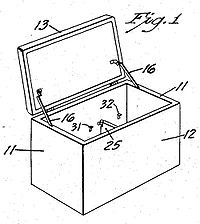- Cooler
-
For other uses, see Cooler (disambiguation).
A cooler, cool box,[1] portable ice chest, chilly bin (in New Zealand), or esky (Australia) most commonly is an insulated box used to keep food or drink cool. Ice cubes are most commonly placed in it to help the things inside stay cool. Ice packs are sometimes used, as they either contain the melting water inside, or have a gel sealed inside that stays cold longer than plain ice (absorbing heat as it changes phase).
The portable ice chest was invented by Richard C. Laramy of Joliet, Illinois. On February 24, 1951, Laramy filed an application with the United States Patent Office for a portable ice chest (Serial No. 212,573). The patent (#2,663,157) was issued December 22, 1953.
The Coleman Company popularized the cooler, sometimes known as an "ice box" in the United States, with its initial offering of a galvanized cooler in 1954. Three years later, Coleman developed a process to make a plastic liner for coolers and jugs.
Coolers are often taken on picnics, and on vacation or holiday. Where summers are hot, they may also be used just for getting cold groceries home from the store, such as keeping ice cream from melting in a hot automobile. Even without adding ice, this can be helpful, particularly if the trip home will be lengthy.
They are usually made with interior and exterior shells of plastic, with a hard foam in between. They come in sizes from small personal ones to large family ones with wheels. Disposable ones are made solely from polystyrene foam (such as is a disposable coffee cup) about 2 cm or one inch thick. Most reusable ones have molded-in handles; a few have shoulder straps. The cooler has developed from just a means of keeping beverages cold into a mode of transportation with the Ride on Cooler.
In the United Kingdom the common name is a "cool-box". In the United States they are usually called a "cooler". In New Zealand they are generally called a "chilly bin", a genericized trademark; the common Australian name of "Esky" is also a genericized trademark.
Thermoelectric coolers
Some modern coolers are thermoelectric, plugging in to a car's cigarette lighter socket. Rather than using a compressor and refrigerant such as a refrigerator or other heat pump, these use the Peltier effect along with an external fan to draw away the heat. By reversing the current, this concept can also heat the contents instead of cooling them, useful for keeping meals hot from a drive-through, or even to keep items from freezing in severely cold climates.
Thermoelectric coolers typically can drop the temperature by about 40°F or 22°C below ambient temperature, or can raise it by at least that much; this is really a function of the effectiveness of the insulation, due to the fact that sometimes it needs to be about 20% cooler. Some better units even have digital thermostat controls. They do draw a significant amount of power, however, and can drain a car's battery so much so that it cannot start. Most electric coolers have an undervoltage shutoff at around 10 or 10.5 volts to prevent this. Many come with power adapters, which use an electronic transformer to convert AC mains or line voltage (100 to 240) down to 12 volts, with a lighter-like socket for the cooler's cord to plug in. Some also have a crossover-connection device to reverse the current for heating service.
See also
- Insulated shipping container
- Thermal insulation
- Ride-on cooler
References
Categories:- Food preservation
- Food storage containers
Wikimedia Foundation. 2010.

